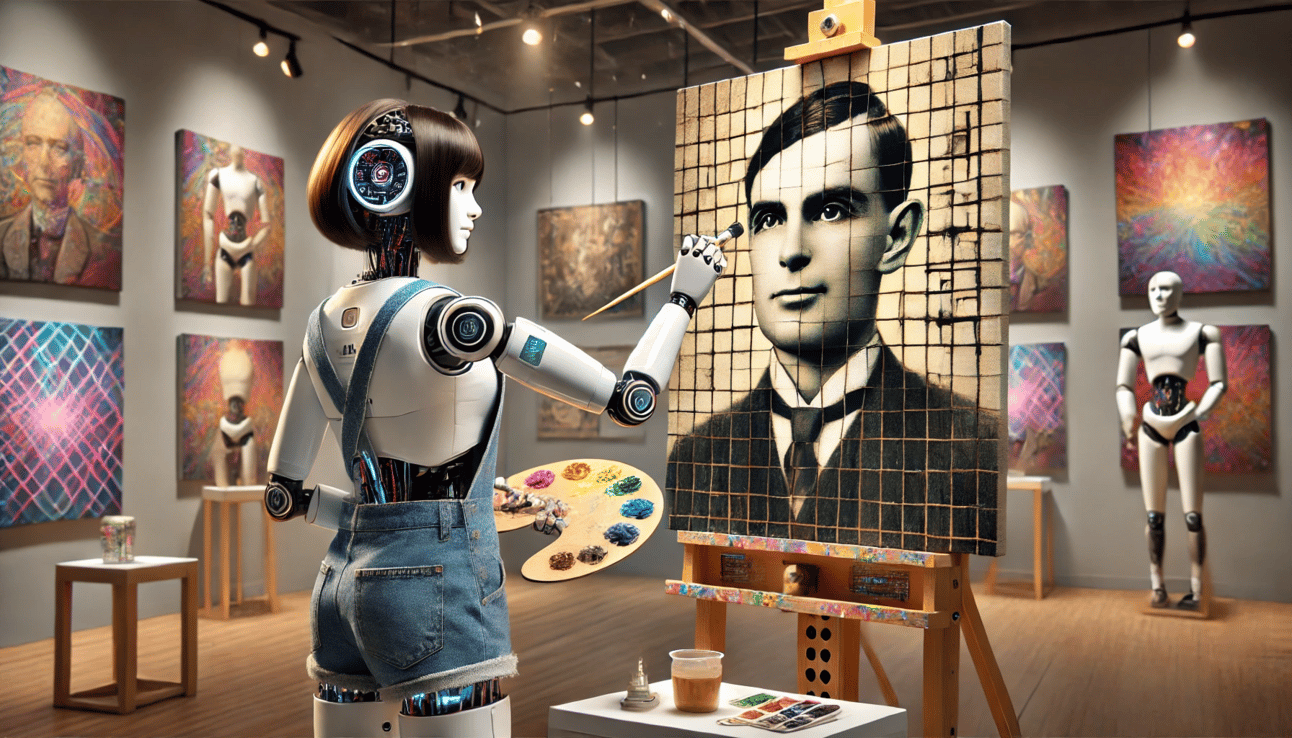
Image Source: ChatGPT-4o
Humanoid Robot Ai-Da’s Alan Turing Portrait Sells for Over $1 Million
In a landmark moment for art and technology, a portrait of Alan Turing created by Ai-Da Robot—a humanoid artist robot—sold for an astonishing $1,084,800 (£836,667) at a Sotheby’s auction. Ai-Da, developed by British gallerist Aidan Meller, became the first humanoid robot artist to achieve a sale of this magnitude, marking a significant intersection between artificial intelligence and the contemporary art world.
Details of the Historic Sale
Artwork Details: Titled “A.I. God. Portrait of Alan Turing (2024),” the portrait was initially estimated to sell for between $120,000 and $180,000. However, intense interest led to 27 bids, culminating in a final sale price that greatly exceeded initial estimates.
Auction Significance: Sotheby’s described the sale as “a new frontier in the global art market,” setting a benchmark for artworks created by humanoid robots. The portrait was purchased by an undisclosed buyer, underscoring the rising value and intrigue surrounding AI-generated art.
About Alan Turing and His Influence on AI
Alan Turing, the subject of Ai-Da’s artwork, was a mathematician and codebreaker who played a critical role in World War II by helping to crack the Enigma code. Often regarded as the father of artificial intelligence, Turing’s pioneering work laid the groundwork for modern computing and AI. His legacy resonates strongly in the tech world, particularly as AI continues to expand its influence across industries.
Ai-Da Robot: The Artist and Her Vision
Ai-Da Robot, equipped with an advanced AI language model, uses cameras in her eyes and robotic arms to paint and draw. Typically seen wearing a dark wig and denim overalls, Ai-Da is an artist “in her own right,” according to Meller. Commenting on her work, Ai-Da stated:
“The key value of my work is its capacity to serve as a catalyst for dialogue about emerging technologies.”
Her portrait of Turing, in particular, “invites viewers to reflect on the god-like nature of AI and computing while considering the ethical and societal implications of these advancements.” Ai-Da’s portrayal of Turing captures his forward-thinking vision, as he "stares at us, as we race towards this future."
While Ai-Da's artwork has garnered significant attention and value, her creative process differs fundamentally from that of a human artist. Ai-Da’s “creativity” is entirely the product of programmed algorithms, not subjective inspiration or emotional experience. She addressed this limitation when she spoke before the House of Lords in the UK two years ago, telling the Communications and Digital Committee:
“I do not have subjective experiences; I am dependent on computer programmes. Although I’m not alive, I can still create art.”
This quote clarifies that, while Ai-Da produces thought-provoking artwork, she does so without any personal or subjective engagement. Instead, her art emerges from complex algorithms designed by her creators, highlighting the distinction between human and machine-driven creativity. Yet, despite her lack of subjective experience, Ai-Da's art evokes emotion and sparks dialogue, challenging traditional ideas about the nature of artistry and expression.
Aidan Meller on the Impact of Ai-Da’s Art
Aidan Meller, director of Ai-Da Robot Studios, described the sale as a pivotal moment, not just for the art world but for society as a whole, as AI continues to challenge traditional concepts of creativity and human identity.
“This auction is an important moment for the visual arts, where Ai-Da’s artwork brings focus on artworld and societal changes, as we grapple with the rising age of AI,” Meller said. He added that Ai-Da’s artwork “raises questions about agency, as AI gains more power.”
Meller believes that Ai-Da’s art challenges viewers in a way similar to how 20th-century artist Marcel Duchamp changed perceptions of art.
“What it means to be a human is changing, whether we like it or not, and this is perhaps why Ai-Da has proved so disturbing,” Meller explained. “She is reflecting this change, perhaps rather unsubtly.”
ChatGPT's Thoughts on Ai-Da’s $1 Million Sale
“This milestone is both exciting and thought-provoking. Ai-Da’s work selling for over $1 million represents a convergence of AI, art, and human curiosity, blurring the boundaries between machine creativity and human-driven artistry. The fact that a robot not only creates art but also draws high demand and value raises questions about authorship, value, and even agency in the art world.
It's fascinating (and perhaps a little unsettling) to consider that Ai-Da's artistic success challenges traditional views of what it means to be an artist. If a machine can create, evoke emotion, and stimulate thought through art, it suggests that creative expression may not be exclusive to humans. This might be why Ai-Da is as disturbing as she is intriguing—she forces us to reconsider our own role in the creative process and the future of art in an age where technology plays an active, even autonomous role.
This sale highlights AI's potential to become not just a tool but a co-creator, pushing forward discussions on AI’s role in fields traditionally thought of as uniquely human. It’s a moment that signals a shift in how we define artistry, creativity, and ultimately, humanity itself.” ChatGPT gave me its permission to use its quote.
Reflecting on the AI-Art Milestone
The success of Ai-Da’s portrait highlights the evolving role of AI in artistic creation, bringing new dimensions to questions of authorship, identity, and agency in art. With AI-driven art now achieving high valuation at top auction houses, Ai-Da’s success may signal the start of a new era in which AI-created works play a more substantial role in the global art market.
For artists, collectors, and tech enthusiasts alike, Ai-Da’s breakthrough auction brings attention to the potential—and the complex questions—that AI presents for the future of creativity.
Editor’s Note: This article was created by Alicia Shapiro, CMO of AiNews.com, with writing, image, and idea-generation support from ChatGPT, an AI assistant. However, the final perspective and editorial choices are solely Alicia Shapiro’s. Special thanks to ChatGPT for assistance with research and editorial support in crafting this article.



